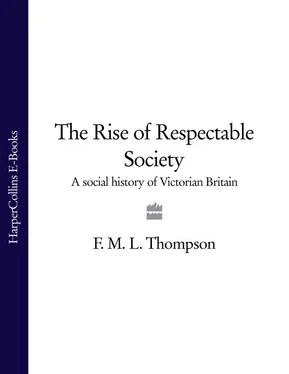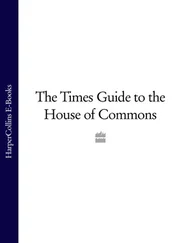Agriculture had long been in relative decline, certainly since the early seventeenth century if not before, since it is the essence of commercial and industrial growth that the non-agricultural proportion of the population should increase, fed and supplied either by the increasing efficiency of those who worked on the land, or by growing advantages and opportunities for importing agricultural produce. Both had been happening in Britain, although since in the early 1830s, given normal to good harvests, the country was virtually feeding itself, the emphasis had been on improvements in agricultural productivity, bolstered by growing imports of grain and livestock from Ireland. Agriculture had probably ceased to provide the livelihood of a majority of the population before the middle of the eighteenth century, and the agricultural sector had declined from over a third of the working population at the beginning of the nineteenth century to a quarter by 1831. Nevertheless, the actual numbers engaged in farming were still increasing, growing from about 1 3/ 4million then to the historical peak of over 2 million in 1851; it was only from the plateau of the 1850s that the long and practically uninterrupted decline in the number of farmworkers began. These numbers included nearly 300,000 farmers, about half of whom employed some hired labour while the other half used only the labour of themselves and members of their families. That left something like a million agricultural labourers, landless and propertyless, owning neither their homes nor their tools, and entirely reliant on wage labour. This was far and away the largest single occupation of male workers, about twice the size of the next largest group, those working in textiles of all sorts, and not far short of three times larger than the body of workers in the building trades. Many women also worked in agriculture, some full-time like the dairymaids, the members of the new and growing labour gangs in East Anglia, or the Northumbrian bondagers who were regular field workers as brawny as any men; many more were drawn in at the seasonal work peaks of turnip hoeing and singling, or harvest. Ambiguities of self-perception and of definition make the number of women who described themselves as agricultural workers (in the 1841 census) somewhat suspect; they appear to have been the fourth largest group of women workers, after those employed in domestic service, textiles, and the clothing trades, but they may have been more numerous than the 80,000 enumerated in 1841 or 230,000 in 1851.
Insofar as it makes any sense at all to look for the average British workingman, he was to be found in 1830 working in the broadly defined industrial sector, but not in a factory; the most representative workingman, however, was the agricultural labourer. The typical working woman, there is no doubt, was a domestic servant. The nature of work is a major influence on a person’s sense of identity, but its place is scarcely less important, and most people lived and worked in the countryside, whether directly involved in farming or not. It was not until 1851 that a majority of the British population was classified as being urban, on the unexacting definition of living in a place with 2000 or more inhabitants. Population size is a convenient, but rough and ready, measure of urbanity; while the judgement of contemporaries in the Registrar-General’s office should be respected, that this size represented the dividing line between country and town, it is clear that many of the smallest notional ‘towns’ would have been overgrown villages, their inhabitants as close to the land in their way of life as their cottages were to the surrounding open country. It should be acknowledged that small country towns like Aberystwyth (Cardiganshire), Burford (Oxfordshire), Midhurst (Sussex), Sedbergh (West Riding), or Spilsby (Lincolnshire), all of which had populations in the 1500–2000 range in the 1830s, were unmistakably town-like in the sense that they were something more than collections of agricultural workers and agricultural trades. They performed marketing, administrative, and professional functions for their rural hinterlands; and in their small way they looked like towns in layout and contiguity of buildings. Nevertheless, diminutive towns like these, and the great majority of the places which clearly had the look and feel of towns, were essentially traditional country towns. In 1831 about 90 per cent of the places which physically and often administratively were towns had populations of under 20,000, and in most of them the inhabitants were accustomed to country sights, sounds, and smells in the streets, and had strong links of kinship or friendship in the surrounding countryside. This considerable slice of the ‘urban’ population remained, therefore, well integrated into a traditional economic and social order, and by and large had not recently experienced upheavals in jobs or living conditions, or changes in the texture and scale of their environment, of a kind likely to produce disruptive social effects or to alienate them from established authorities in church, corporation, and neighbouring country house.
To be sure, the 20,000 threshold, like any other, is no more than an approximate and imperfect guide to a town’s character, and there were places like Bury, Wigan, Bradford, or Huddersfield which had only just crossed it or were poised to do so, that were unmistakably parts of the new industrial order. All the same, it was in the really large towns that a new kind of urban society was taking shape; it was there that the sheer scale of concentration of numbers produced something like a quantity – quality change and threw up those features of segregation, social distancing, overcrowding, pollution, public order, and health hazards most commonly associated with nineteenth-century urban living. In 1831 about one quarter of the total British population lived in towns with more than 20,000 inhabitants, but the essentially urban element of society may be usefully visualized as smaller than that. By 1951, it should be noted, over half the population lived in urban clusters with more than 100,000 people, and that has become the normal setting of the typical British citizen. By contrast, in 1801 there had been no towns in Britain, outside London, with as many as 100,000 inhabitants. By 1831 there were seven – Manchester, Glasgow, Liverpool, Edinburgh, Birmingham, Leeds, and Bristol – and together with London they contained one sixth of the total population. This fraction, it can be argued, was both the central core and the advanced guard of modern urban society. It was here and in the next layer of the urban hierarchy that the most rapid and dramatic social changes took place, here that the most pressing problems and acute tensions and contrasts developed, here that new habits and lifestyles were evolved which ultimately percolated through to the rest of the country, and here that familiar and accustomed patterns of behaviour were most strongly challenged.
This was also the most rapidly expanding face of society in the nineteenth century, for by 1901 there were nearly forty towns over the 100,000 mark and between them they accounted for well over one third of the total population. To put it another way, 10 million out of the net increase in British population between 1831 and 1901 of 11 million lived in these very large towns, which can thus be said to have monopolized expansion. The most significant point, however, was that the large-town urban base of early Victorian Britain, although not inconsiderable, was comparatively small. Moreover, at least two thirds of that base was occupied by London, and whatever the metropolitan scene offered in lavish wealth or abject poverty, magnificent buildings or filthy courts, happiness or misery, social harmony or social conflict, it was not exactly a new phenomenon. Already for several centuries government and society had been obliged to come to terms with the existence of a huge concentration of people in London, and to adjust to the consequences of the fact that a tenth or more of the entire population lived there. This is not to say that London was necessarily a static or particularly stable and unproblematic element in society, nor that it exercised a constant and predictable influence on the rest of the country. Far from it. The internal dynamics of changes within London in its size and structure, and the external dynamics of its changing relationships with Britain and the rest of the world, were and continued to be of fundamental importance in determining the main lines of British social, just as much as economic, development. It does imply, however, that the experience of urban life on the metropolitan scale, and of London’s impact on the lives of provincials and countrymen, had been absorbed and familiarized over the preceding generations into a normal and accepted feature of the early Victorian social fabric.
Читать дальше












